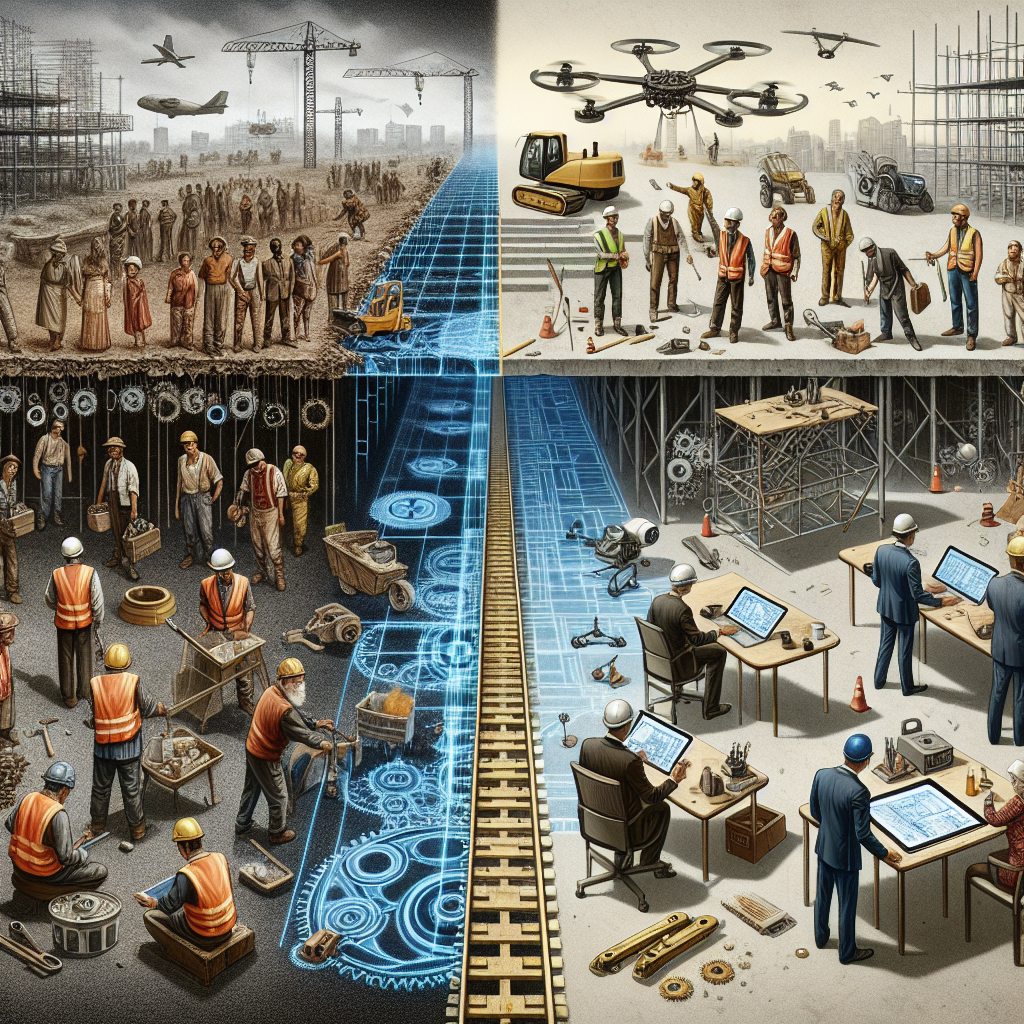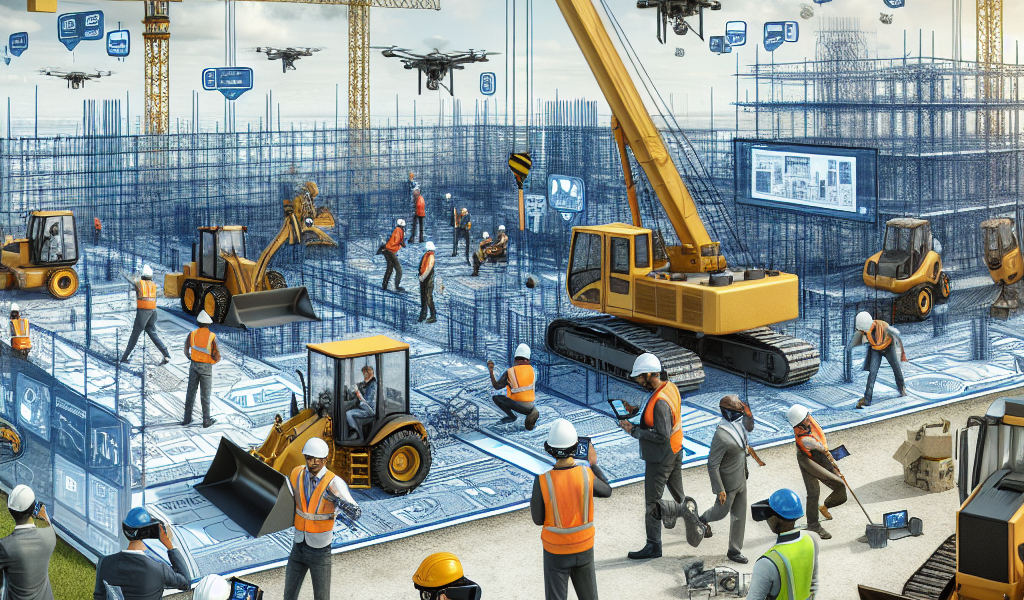-
Table of Contents
“Building the Future: How Technology Transforms Construction”
Introduction

The construction industry, a cornerstone of global economic development, has undergone a significant transformation with the advent of advanced technology. The integration of innovative tools and digital solutions has revolutionized traditional construction practices, enhancing efficiency, safety, and sustainability. From Building Information Modeling (BIM) and drones to 3D printing and artificial intelligence, technology has reshaped the way projects are designed, managed, and executed. This evolution not only streamlines operations but also addresses critical challenges such as labor shortages, cost overruns, and environmental impact. As the industry continues to embrace these technological advancements, it stands on the brink of a new era, characterized by smarter, faster, and more resilient construction processes.
Innovations in Construction: How Technology is Revolutionizing Building Techniques
The construction industry, long perceived as a bastion of traditional methods and manual labor, is undergoing a remarkable transformation thanks to the advent of cutting-edge technology. This revolution is not just about replacing hammers with robots or blueprints with digital models; it is about fundamentally rethinking how buildings are designed, constructed, and maintained. As we delve into the innovations reshaping this sector, it becomes evident that technology is not merely an add-on but a game-changer.
To begin with, Building Information Modeling (BIM) has emerged as a cornerstone of modern construction practices. BIM allows for the creation of detailed 3D models that encompass every aspect of a building’s lifecycle, from design to demolition. This digital representation enables architects, engineers, and contractors to collaborate more effectively, reducing errors and ensuring that everyone is on the same page. Consequently, projects are completed faster and with fewer costly mistakes, which translates to significant savings for developers and clients alike.
Moreover, the integration of drones into construction sites has revolutionized the way projects are monitored and managed. Drones provide real-time aerial views, allowing for precise site surveys and progress tracking. This bird’s-eye perspective not only enhances safety by identifying potential hazards but also improves efficiency by offering insights that would be difficult to obtain from the ground. As a result, project managers can make informed decisions quickly, keeping timelines on track and budgets under control.
In addition to drones, robotics is making a substantial impact on construction techniques. Robots are now capable of performing tasks that were once considered too dangerous or labor-intensive for human workers. For instance, bricklaying robots can lay thousands of bricks per day with pinpoint accuracy, while demolition robots can safely dismantle structures in hazardous environments. These advancements not only increase productivity but also enhance worker safety, as robots can take on the most perilous tasks.
Transitioning from the physical to the digital, the Internet of Things (IoT) is another technological marvel transforming construction. IoT devices, embedded in machinery and building materials, collect and transmit data in real-time. This connectivity allows for predictive maintenance, where potential equipment failures can be identified and addressed before they cause delays. Additionally, smart sensors embedded in concrete can monitor curing conditions, ensuring optimal strength and durability. This level of precision was unimaginable just a few years ago and is now becoming standard practice.
Furthermore, the rise of sustainable construction practices is closely tied to technological advancements. Green building technologies, such as energy-efficient HVAC systems and solar panels, are becoming more sophisticated and cost-effective. Advanced materials like self-healing concrete and aerogels are also gaining traction, offering enhanced durability and insulation properties. These innovations not only reduce the environmental impact of construction projects but also result in long-term cost savings for building owners.
As we look to the future, it is clear that technology will continue to drive the evolution of the construction industry. Augmented reality (AR) and virtual reality (VR) are poised to become integral tools, allowing stakeholders to visualize projects in immersive detail before a single brick is laid. 3D printing, too, holds promise for creating complex structures with unprecedented speed and precision.
In conclusion, the impact of technology on the construction industry is profound and far-reaching. From BIM and drones to robotics and IoT, these innovations are revolutionizing building techniques, making construction safer, more efficient, and more sustainable. As technology continues to advance, the possibilities for further transformation are limitless, heralding a new era in construction that promises to reshape our built environment in ways we are only beginning to imagine.
The Role of Artificial Intelligence in Enhancing Construction Project Management
Artificial intelligence (AI) is revolutionizing various sectors, and the construction industry is no exception. As the demand for more efficient, cost-effective, and safer construction practices grows, AI is stepping in to transform project management in ways previously unimaginable. This technological advancement is not just a fleeting trend but a significant shift that promises to redefine how construction projects are planned, executed, and completed.
To begin with, AI enhances the accuracy of project planning. Traditional methods often rely on historical data and human intuition, which can be prone to errors and biases. AI, however, leverages vast amounts of data to predict potential challenges and optimize resource allocation. For instance, machine learning algorithms can analyze past projects to forecast timelines, budget requirements, and resource needs with remarkable precision. This predictive capability allows project managers to make informed decisions, reducing the likelihood of costly overruns and delays.
Moreover, AI-driven tools are improving the efficiency of construction site management. Drones equipped with AI technology can monitor construction sites in real-time, providing project managers with up-to-date information on progress and potential issues. These drones can capture high-resolution images and videos, which are then analyzed by AI systems to detect anomalies such as structural weaknesses or safety hazards. Consequently, this real-time monitoring enables swift corrective actions, ensuring that projects stay on track and adhere to safety standards.
In addition to enhancing planning and site management, AI is also playing a crucial role in improving communication and collaboration among project stakeholders. Construction projects often involve multiple parties, including architects, engineers, contractors, and clients. AI-powered platforms facilitate seamless communication by centralizing project data and providing real-time updates. These platforms use natural language processing to interpret and relay information accurately, minimizing misunderstandings and fostering a collaborative environment. As a result, all stakeholders remain aligned, and the project progresses smoothly.
Furthermore, AI is instrumental in optimizing resource management. Construction projects require a myriad of resources, from materials to labor. AI algorithms can analyze data on material usage, labor productivity, and equipment performance to identify inefficiencies and suggest improvements. For example, AI can predict when a particular piece of equipment is likely to fail, allowing for proactive maintenance and reducing downtime. Similarly, AI can optimize material procurement by predicting demand and minimizing waste, leading to significant cost savings.
Safety is another critical area where AI is making a substantial impact. Construction sites are inherently hazardous, and ensuring worker safety is paramount. AI-powered wearable devices can monitor workers’ vital signs and environmental conditions in real-time, alerting them to potential dangers such as heat stress or exposure to harmful substances. Additionally, AI systems can analyze accident data to identify patterns and recommend preventive measures, thereby reducing the risk of future incidents.
While the benefits of AI in construction project management are evident, it is essential to acknowledge the challenges that come with its adoption. Integrating AI into existing workflows requires significant investment in technology and training. Moreover, there may be resistance from industry professionals who are accustomed to traditional methods. However, as the advantages of AI become increasingly apparent, it is likely that more construction companies will embrace this technology, leading to widespread improvements in project management.
In conclusion, AI is poised to transform construction project management by enhancing planning accuracy, improving site management, facilitating communication, optimizing resource use, and bolstering safety. As the construction industry continues to evolve, the integration of AI will undoubtedly play a pivotal role in shaping its future, making projects more efficient, cost-effective, and safe for all involved.
Sustainable Construction: Leveraging Technology for Eco-Friendly Building Practices
The construction industry, traditionally known for its reliance on manual labor and heavy machinery, is undergoing a significant transformation. This change is largely driven by the integration of advanced technologies aimed at promoting sustainable building practices. As the world grapples with the pressing need to address climate change and reduce carbon footprints, the construction sector is increasingly turning to innovative solutions to build eco-friendly structures. This shift not only helps in conserving natural resources but also ensures long-term economic benefits.
One of the most notable advancements in sustainable construction is the use of Building Information Modeling (BIM). BIM allows architects, engineers, and construction professionals to create detailed 3D models of buildings before the actual construction begins. This technology facilitates better planning and coordination, reducing waste and optimizing resource use. By simulating various scenarios, BIM helps in identifying potential issues early on, thereby minimizing the need for rework and conserving materials. Moreover, it enables the integration of energy-efficient systems and sustainable materials right from the design phase, ensuring that the final structure is both eco-friendly and cost-effective.
In addition to BIM, the advent of smart building technologies has revolutionized the way buildings are constructed and managed. Smart sensors and IoT (Internet of Things) devices can monitor energy consumption, water usage, and indoor air quality in real-time. These insights allow building managers to make informed decisions that enhance energy efficiency and reduce environmental impact. For instance, smart lighting systems can adjust brightness based on natural light availability, while smart HVAC systems can optimize heating and cooling based on occupancy patterns. Such technologies not only contribute to sustainability but also improve the overall comfort and well-being of occupants.
Furthermore, the use of sustainable materials is gaining traction in the construction industry. Traditional building materials like concrete and steel have a significant environmental footprint due to their energy-intensive production processes. In contrast, materials such as cross-laminated timber (CLT), recycled steel, and low-carbon concrete offer more sustainable alternatives. CLT, for example, is made from sustainably harvested wood and has a lower carbon footprint compared to conventional materials. Additionally, it provides excellent thermal insulation, reducing the need for artificial heating and cooling. By incorporating these eco-friendly materials, construction companies can significantly reduce the environmental impact of their projects.
Another promising development is the rise of modular and prefabricated construction. This approach involves manufacturing building components in a controlled factory environment and then assembling them on-site. Modular construction not only speeds up the building process but also minimizes waste and energy consumption. The precision of factory production ensures that materials are used efficiently, and any excess can be recycled. Moreover, the controlled environment reduces the risk of weather-related delays and damage, further enhancing sustainability.
The integration of renewable energy sources into building designs is also a key aspect of sustainable construction. Solar panels, wind turbines, and geothermal systems can be incorporated into buildings to generate clean energy, reducing reliance on fossil fuels. For example, solar panels can be installed on rooftops to harness sunlight and convert it into electricity, while geothermal systems can provide heating and cooling by tapping into the earth’s natural temperature. These renewable energy solutions not only lower greenhouse gas emissions but also offer long-term cost savings for building owners.
In conclusion, the construction industry is embracing technology to drive sustainable building practices. From advanced modeling tools and smart building systems to sustainable materials and renewable energy integration, these innovations are paving the way for a greener future. As technology continues to evolve, the potential for creating eco-friendly, energy-efficient buildings will only grow, benefiting both the environment and society as a whole.
Conclusion
The impact of technology on the construction industry has been profound, driving significant advancements in efficiency, safety, and productivity. Innovations such as Building Information Modeling (BIM), drones, 3D printing, and automation have revolutionized project planning, design, and execution. These technologies enable better collaboration, reduce errors, and optimize resource management, leading to cost savings and faster project completion. Additionally, advancements in materials science and sustainable practices are promoting eco-friendly construction methods. Overall, technology is transforming the construction industry, making it more efficient, sustainable, and capable of meeting the demands of modern infrastructure development.





